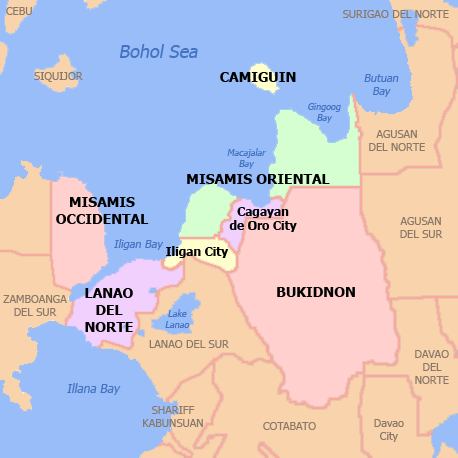Exploring Region 10: Northern Mindanao, Philippines
Northern Mindanao, officially designated as Region 10, is a vibrant and diverse administrative region in the Philippines.
Nestled in the northern part of the island of Mindanao, it is a region known for its rich cultural tapestry, stunning landscapes, and rapidly growing economy.
This article delves into the heart of Northern Mindanao, exploring its geography, culture, and economic significance.
Also Read: List of Regions in the Philippines
Key Takeaways:
| Attribute | Value |
|---|---|
| Land Area (2013) | 204.59 km2 (7899.07 sq mi) |
| Population as of 01 May 2020 | 5,022,768 |
| Regional Center | Cagayan De Oro |
| Provinces of Region 8 | Bukidnon, Camiguin, Lanao del Norte, Misamis Occidental, and Misamis Oriental |
| Highly urbanized city | Cagayan De Oro and Iligan |
| Consists of | 9 cities 84 Municipalities and 2,022 Barangays |
Region 10 Map
Geography and Demographics
Northern Mindanao encompasses a land area of 204.59 km2 (7899.07 sq mi).
As of the 2020 census, it was home to approximately 5,022,768 people. This figure makes it the 8th most populous region in the entire country and the 2nd most populous in Mindanao, trailing only behind Davao.
The region is divided into five provinces: Camiguin, Bukidnon, Lanao Del Norte, Misamis Occidental, and Misamis Oriental. These provinces contribute to the rich cultural diversity and economic activities that shape Northern Mindanao.
Region 10 Provinces
Bukidnon
Bukidnon, a landlocked province that is the largest and most populous in the region. It is known as the “Food Basket of Mindanao” because of its abundant agricultural resources.
It also has natural attractions, such as mountains, volcanoes, waterfalls, springs, caves, and beaches. It also has rich cultural heritage, evident in its festivals, cuisines, arts, and crafts.
Camiguin
Camiguin, an island province that is the smallest and least populous in the region. It is known as the “Island Born of Fire” because of its seven volcanoes, four of which are still active.
It also has natural attractions, such as hot and cold springs, waterfalls, sandbars, and coral reefs. It also has historical and cultural landmarks, such as churches, ancestral houses, and monuments.
Lanao Del Norte
Lanao del Norte, a coastal province that is located in the western part of the region. It is known as the “Land of Beauty and Bounty” because of its scenic landscapes, rich natural resources, and diverse cultures.
It also has natural attractions, such as lakes, rivers, waterfalls, caves, and forests. It also has historical and cultural attractions, such as mosques, shrines, museums, and festivals.
Misamis Occidental
Misamis Occidental, a coastal province that is located in the northern part of the region. It is known as the “Eco-Tourism Capital of Northern Mindanao” because of its efforts to preserve and promote its natural and cultural heritage.
It also has natural attractions, such as mangrove forests, marine sanctuaries, and wildlife parks. It also has historical and cultural attractions, such as churches, forts, museums, and festivals.
Misamis Oriental
Misamis Oriental, a coastal province that is located in the eastern part of the region. It is known as the “Gateway to Northern Mindanao” because of its strategic location and accessibility.
It also has natural attractions, such as beaches, islands, waterfalls, and mountains. It also has historical and cultural attractions, such as churches, monuments, museums, and festivals.
Urban Centers and Regional Center
Northern Mindanao boasts two highly urbanized cities: Cagayan de Oro City and Iligan City. Cagayan de Oro City serves as the regional center and a hub of commerce, culture, and administration for the region.
The two cities are vital players in the region’s economic development and growth.
Religion and Culture
The predominant religion in Northern Mindanao is Roman Catholicism, with approximately 72% of the population adhering to this faith.
However, there are also significant populations of Protestants and Muslims, contributing to the region’s religious diversity.
The cultural fabric of Northern Mindanao is rich and diverse, with a multitude of dialects spoken. Cebuano, Maranao, Hiligaynon, Subanon, Bukid, Kamigin, Ilianen, Matigsalug, and Iranun are just a few of the languages spoken in the region.
Many of its inhabitants can trace their ancestry back to Cebu and Bohol, highlighting the historical migration patterns that have shaped Northern Mindanao.
In 2001, Lanao Del Norte was transferred to Northern Mindanao from Region 12, marking a significant administrative change.
Etymology
The name “Northern Mindanao” was officially coined during the American colonial period, following the establishment of American rule in the Philippines.
It was chosen, in part, due to the suppression of Filipino revolutionaries who had fought for independence from Spanish colonial rule.
Interestingly, there have been other proposals to change the region’s name. “Amihanan Region,” meaning “Northern Area” in Cebuano, and “CALAMINON,” an acronym formed from the region’s provinces, have been suggested as alternatives.
Economy and Industry
The economy of Northern Mindanao is primarily based on agriculture, forestry, fishing, and hunting. It is an important agricultural region in the Philippines, producing top commodities such as bananas, pineapples, chickens, hogs, and corn.
These products are not only staples in the local diet but are also significant contributors to the national agricultural output.
Moreover, the region plays a crucial role in the energy sector. The Agus-IV to VII Hydroelectric Plants in Iligan and Balo-i, Lanao del Norte, supply a substantial portion of the electrical power in Mindanao.
This has helped meet the energy demands of the region and neighboring areas.
In recent years, Northern Mindanao has experienced a boom in industrial and manufacturing sectors, particularly in Iligan and Cagayan De Oro.
These cities have become centers of commerce and industry, offering employment opportunities and contributing to the region’s economic development.
Conclusion
Northern Mindanao, or Region 10, is a region of great significance in the Philippines. With its cultural diversity, agricultural prowess, and rapidly growing economy, it plays a vital role in the nation’s development.
As the region continues to evolve and embrace new opportunities, Northern Mindanao promises to be a dynamic and exciting part of the country.

